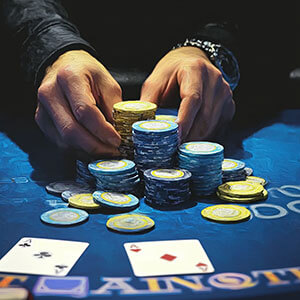Sit n Go Advanced Strategy: Blind Steals in the SNG Middle Stage
The blind steal is a crucial move to master to be a successful SNG player. Understanding the mechanics of the blind steal makes it easier. The typical middle stage of a single table sit and go tournament is the time when there are five to seven players remaining, and the blinds are roughly one eighth of the average stack, and it is a ripe time for stealing blinds.
Table Dynamics
First of all you need to be aware of the table dynamics, before you just start to try and steal peoples blinds. How did you get to this point in the tournament, and what are your opponents playing like?
Loose and Aggressive Table
Were the players loose and aggressive with lots of big swings in stack size? In that case, playing a slightly more cautious game and waiting for a big chance might be best. This table is loosened up, and a steal play with weak cards is more likely to get called or re-raised. Don’t let your stack get below about 7 or 8 big blinds, though, or you will be too weak to play later on. If the table played out wildly in the early stages and you’re now down to four or five players, securing a third-place finish might represent a reasonable result in this situation.
Passive Table
If the table was very passive in the early stages, you might see as many as eight players still in at this stage, with most stacks about the same size. Once the blinds reach a point where they represent around one eighth to one tenth of the average stack, blind steals can become an important tactical option — and at a tighter table, they may be more likely to succeed.
Steal Mechanics
The farther away from the button you are, the better of a hand you want to make a play at the blinds. With blinds at 100/200 and your stack near average at 2,500, if you raise to 600, and get re-raised all in, you will be getting 2-1 odds to call an all in move, which are very tempting. It would be nice to have some sort of decent hand to take a chance with. Raising and then folding preflop from middle position is bad poker. Raise with a hand you’d be comfortable taking 2-1 odds all in with.
As you get closer to the button, your hand requirements for raising preflop go way down. With average ABC players sitting behind you, they will be folding to your aggression. They don’t care whether or not you have a hand, they just know that they don’t.
If you raise any two cards from the button, you have real advantages. Here is a look at the math:
- If the players in the blinds are unimaginative ABC players, they will probably not defend their blind with less than a top 20% hand, and will probably only re-raise with the top 10% hands.
- That means that of the times you raise, you will steal the blinds 64% of the time (80% small blind x 80% big blind).
- Of the 36% of the time the steal is not successful, they will re-raise only about 50% of those times because they have a very good hand. When they do re-raise and you have junk, here is a situation where you can consider folding (remember you are getting 2-1 odds to call though).
- The other 50% of the times they defend, they will simply call (often a suboptimal play, since they’ll be out of position for the rest of the hand), and when they miss the flop (two thirds of the time), you can take it down with a continuation bet.
So from the maths, we can see that blind steals in late position is a positive play, in fact only about 18% of the time are we going to run into troubles (36% x 50%) and have to consider folding, the other times we will likely take the pot down before or on the flop.
The blind steal is a valuable strategy for navigating the middle stages of an SNG tournament. When used appropriately as part of an overall game plan, it can improve your chances of building a stack and progressing further in the game.
